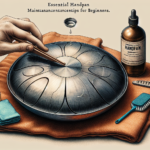Introduction
The handpan is a unique and captivating instrument that has gained a passionate following in recent years. Its ethereal tones and intuitive playing style make it a powerful tool for musical expression. One of the most striking aspects of playing the handpan is the ability to improvise, creating music on the fly without the confines of written notation or predetermined structures. This article delves into the art of handpan improvisation, exploring its techniques, benefits, and the creative freedom it offers.
The Beauty of Improvisation
Improvisation is the act of making up music as you go along. It is a spontaneous, moment-to-moment expression that allows musicians to connect deeply with their instrument and their own emotions. The handpan, with its resonant and melodic qualities, is particularly well-suited to improvisation.
The Expressive Potential
Unlike many traditional instruments that require rigorous training and adherence to complex compositions, the handpan encourages players to explore their own sounds and rhythms. This opens up a world of expressive potential where personal emotions and experiences can be translated into music, often resulting in deeply moving performances.
Techniques for Handpan Improvisation
While improvisation is inherently free-form, there are techniques that can help enhance your improvised performances on the handpan. Here are some useful tips:
- Understand your instrument: Familiarize yourself with the layout and scale of your handpan. Each handpan has a unique set of notes, and knowing their relationships will help you navigate the instrument more fluidly.
- Start simple: Begin with basic patterns and rhythms. As you become more comfortable, you can start exploring more complex sequences and variations.
- Listen and respond: Improvisation is not just about playing notes. It involves listening to the sounds you create and responding to them in a way that feels natural and expressive.
- Create themes: Develop small musical themes or motifs that you can return to throughout your improvisation. This can provide a sense of structure and cohesion to your performance.
- Experiment with dynamics: Vary the intensity and volume of your playing to add emotional depth and contrast to your music.
The Benefits of Handpan Improvisation
Improvising on the handpan offers numerous benefits for both the musician and the listener.
For the Musician
- Creative freedom: Improvisation allows musicians to break free from the constraints of written music, encouraging them to explore new ideas and sounds.
- Emotional expression: The spontaneity of improvisation provides a direct outlet for emotions, making each performance a unique reflection of the player’s current state of mind.
- Skill development: Regular improvisation can enhance a musician’s technical abilities, as well as their understanding of musical theory and structure.
- Mindfulness: Improvising requires a high level of presence and focus, making it a meditative and grounding practice.
For the Listener
- Engagement: Improvised music often feels more alive and immediate, creating a strong connection between the performer and the audience.
- Uniqueness: Each improvised performance is different, offering a one-of-a-kind listening experience.
- Emotional resonance: The authentic expression in improvised music can evoke deep emotional responses from listeners, making it a powerful form of communication.
Developing Your Personal Style
One of the most exciting aspects of handpan improvisation is the opportunity to develop your own unique style. Here are some strategies to help you on this journey:
- Explore different genres: Listen to and play along with music from various genres to broaden your musical vocabulary. This can inspire new techniques and ideas that you can incorporate into your improvisations.
- Learn from others: Watch and listen to other handpan players, both live and online. Pay attention to their techniques, approaches, and how they express themselves through the instrument.
- Experiment: Don’t be afraid to try new things, even if they seem unconventional. Experimenting with different playing styles, rhythms, and sounds will help you discover what resonates with you.
- Reflect: Take time to reflect on your improvisations. Record your sessions and listen back to them, noting what you liked and what you might want to improve or explore further.
Challenges and Overcoming Them
Improvisation can be intimidating, especially for beginners. Here are some common challenges and tips on how to overcome them:
Fear of Making Mistakes
It’s natural to worry about making mistakes, but remember that there are no wrong notes in improvisation. Embrace imperfections as part of the creative process and as opportunities for growth.
Finding Your Voice
It can take time to develop a personal style. Be patient with yourself and keep experimenting. Every improvisation session will bring you closer to finding your unique voice.
Maintaining Flow
Staying in the flow while improvising can be challenging. Practice mindfulness techniques and focus on staying present in the moment. Over time, maintaining flow will become more natural.
Conclusion
Handpan improvisation is a beautiful and evolving art form that offers a wealth of benefits. It allows musicians to connect deeply with their instrument and express themselves in unique and meaningful ways. By embracing the spontaneity and freedom of improvisation, handpan players can unlock new levels of creativity and emotional expression. Whether you are a seasoned player or just starting out, the art of handpan improvisation is a rewarding and enriching journey.
Frequently Asked Questions
1. Can anyone learn handpan improvisation?
Yes, anyone can learn handpan improvisation with practice and patience. The handpan is an accessible instrument, and its intuitive layout makes it suitable for musicians of all skill levels.
2. Do I need to know music theory to improvise on the handpan?
While knowledge of music theory can be helpful, it is not a requirement. Many handpan players improvise based on their ear and intuition. However, understanding basic scales and chords can enhance your improvisation skills.
3. How can I overcome the fear of making mistakes while improvising?
Fear of mistakes is common but remember that improvisation is about exploration and self-expression. Mistakes are part of the learning process. Embrace them as opportunities to grow and develop your musical voice.
4. What should I do if I feel stuck during an improvisation session?
If you feel stuck, try changing your focus or taking a short break. Sometimes stepping away for a moment can help reset your mind. Experiment with different rhythms, dynamics, or themes to find new inspirations.
5. How can I develop my unique style on the handpan?
Developing a unique style takes time and experimentation. Play music from various genres, learn from other players, and reflect on your own improvisations. The more you explore and express yourself, the more your personal style will emerge.





